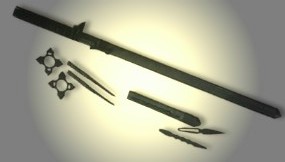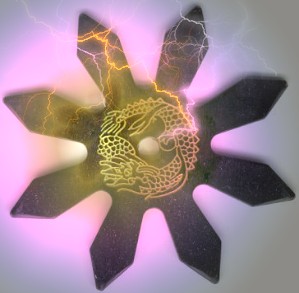|
|
||
|
|
The art of NinjutsuNINJA :Ninjutsu epitomizes the fullest concept of self-protection of not only the physical body, but the mind and spirit as well. The way of the ninja is the way of enduring, surviving, and prevailing over all that would destroy one. More than merely delivering strikes and slashes, and deeper in significance than the simple out-witting of an enemy; ninjutsu is the way of attaining that which we need while making the world a better place. The skill of the ninja is the art of winning. In the beginning study of any combative martial art, proper motivation is crucial. Without the proper frame of mind, continuous exposure to fighting techniques can lead to ruin instead of self-development. If an expert in the fighting arts sincerely pursues the essence of ninjutsu, devoid of the influence of the ego's desires, the student will progressively come to realize the ultimate secret for becoming invincible - the attainment of the 'mind and eyes of the divine.' The combatant who would win must be in harmony with the scheme of totality, and must be guided by an intuitive knowledge. NINPO :"Ninpo", the higher order of ninjutsu, should be offered to the world as a guiding influence for all martial artists... ...Without complete and total training in all aspects of the combative arts, today's martial artist cannot hope to progress any further than mere proficiency in the limited set of muscular skills that make up his or her training system. Personal enlightenment can only come about through total immersion in the martial tradition as a way of living.Principle of a warrior :
|
|
|
|
||
Ninja History :"Ninja" were professional spies during the age of the samurai. Their origins go back to the twelfth century, when the samurai class began to gain power. When the scale of fighting increased in the fourteenth century, it became necessary to conduct espionage activities against enemy forces, and ninja became even more active.Ninja were called upon by their feudal lords to gather information, plunder the enemy's food and weapon supplies, and lead the way in nighttime attacks. They received specialized training and were given special duties. Ninja remained active until the beginning of the Edo period (1600-1868), when social order was restored by the government in Edo (now Tokyo). It was from the latter half of the eighteenth century that ninja became popular subjects of books and dramas. In the twentieth century ninja have been depicted in films using special effects and comics as imaginary characters with superhuman powers. Myths & Mysticism :
Many movies that portray the Historical Ninja as a member of a mystical magical warrior family. The ninja in the movies cast magic spells, project their images, become invisible, fly through the air or even run across water. These inaccuracies are not particularly damaging to the legendary image of the ninja. They even add to the mystery and popularity of ninjutsu. The ninja seems to overlook all concepts of right and wrong and and all morality in order to achieve his self serving goals. None of these concepts are even close
to describing the real ninja. The ninja developed as a highly illegal counterculture to the ruling class of samurai elite. It is for this reason alone that the true origins of the art were shrouded in deliberate mystery and confusion. Tactics :
The
Ninja are revered for their seemingly mystical ability to enter any
structure no matter how well guarded, without being seen or heard.
Although this skill is a reality, it cannot happen without a great deal of
pre-preparation. One does not simply decide to infiltrate on a whim. It
requires an in-depth plan based on the extensive information gathering of
the Teisatsunin (reconnaissance Ninja). A well planned infiltration
operation would only be attempted when the enemy would offer the least
resistance. Once the Ninja has successfully entered , they move on to complete whatever task they were sent to perform. Eavesdropping, assassination, poisoning food and water stores, planting false information, stealing or any other such task.
The "Shinobigatana" is designed to allow for quick maneuvers. its short blade makes it an excellent single handed weapon, but because of its extended hilt it is equally effective when wielded with both hands. All of the Shinobigatana’s unique uses make it the preferred weapon of the warrior. It should be known that the Samurai’s Katana is viewed as being an aggressive weapon, whereas the Ninja’s shorter sword is considered to be more defensive. It is said that the sword can be maneuvered three or four times faster than other weapons, so speed is an important factor in its application. The Ninja sword is designed for speed and concealment. its blade length ranges from between 16 and 24 inches and is usually straight. The straight blade design is known as “Muzori” and this design is also used in the construction of the elusive Shinobi zue (Ninja sword cane) and Nagimaki (halberd). However, it is a common myth that Ninja of old were limited to the use of the straight bladed sword. This is inaccurate. Historical evidence dictates that the Ninja also wielded the curved blades (katana and wakizashi) that are most often associated with the Samurai class.
Please
click here to see next NINJA page-2
|
||

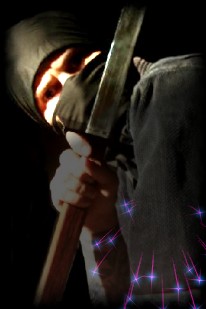

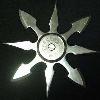
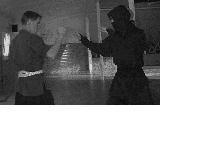
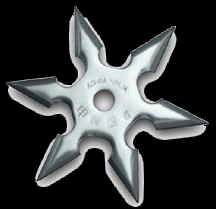

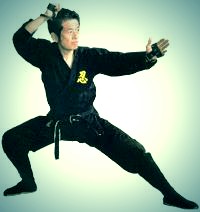
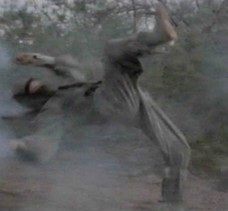



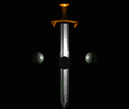 Shinobigatana-jutsu
(art of the Ninja sword) :
Shinobigatana-jutsu
(art of the Ninja sword) : 
